














|
|
Our Swiss Family Bushong
(Unsere Schweizerische Boschŭng)
Of the Simmental
Part One: Beyond Bushong
By Rick Bushong
First Published: January 22, 2015
Revised and Expanded: May 3, 2018
|
Illustration, with liberties, The Wetterhorn with the Reichenbachtal (Stream) in Bern, Switzerland, by Joseph Anton Koch, 1824
|
|
|
 *
Michael Stŭder Boschŭng *
Michael Stŭder Boschŭng | |
 *
Dichtli Jäggi *
Dichtli Jäggi |
1575-___ | |
May 6 1576-____ |
*From church book, 1598, in the clerics hand. Married January 6, 1598
Their Children
- Peter Boschung
- Hans Boschung I
- Salomia Boschung
- Madln Boschung
- Christian(?) Boschung
|
In west central Switzerland, is the canton of Bern. Located in the southwest corner of Bern, and settled amidst some of its most rugged mountains is an area known as Obersimmental. This is where the Simmen Valley, or in German, Simmental can be found. Through the valley, which expands in a more or less south to north direction, flows the Simme River. Small towns and churches dot the sunny terrace, along the northern side of the valley and river. Towns such as Lenk, St. Stephan, Zweisimmen, Boltigen, Oberwil, Därstetten, Erlenbach, and Diemtigen before ending near Wimmis. It is in the Simmental, surrounded by unsurpassed alpine beauty, where we find the cradle of not just the entire American Bushong family line, but of Boschungs who stayed in Germany and Switzerland.
The Colonial Bushong Family's tree continues into obscurity, back before recorded history. However, the beginning of the family's association with its traditional surname, in its original German-Swiss spelling, "Boschŭng," begins with a break from its past. For reasons unknown, sometime towards the end of the sixteenth century, a man, named Michael Studer changed his name to Boschung.1 We know he changed his name, because in 1598, when he married, the Boltigen Church cleric recorded Michael Studer's name, in his church's book, and added "(geándert Boschung),"1; View original inscription. or some form of it. Roughly translated it simply means "(changed Boschung)".2

An early detailed Swiss Map, made in 1637. The Simmental, with Lenk, Zweisimmen, Boltigen, and Oberwil are enlarged.
Click to enlarge. For unmarked map, click here
|
|
He was born around 1575, yet by January 1595, when he baptized a son, he had changed his name and was living in or near Boltigen.1 But before that little is known, and why he changed his name or why he chose Boschung, we can only speculate. As discussed in a prior article, here, the Boschung name had been around Switzerland and specifically the cantons of Bern and nearby Fribourg, as early as,
the 1520s and 1530s. Maybe he had heard the name and just liked it. In the same time period as Michael, there was a Catharina Boschung attending the Boltigen Parish. Had she changed her name too? Could they be from the same Studer family as Michael? Actually in 1594, Catharina, who was apparently single, baptized a daughter Margaret, while the father's name was left blank.1; View original Some six months later when Michael's first son, Peter was baptized, two of the three witnesses were the same people as at Margaret Boschung's baptism.1; View original. So there seems to be an association, but any blood relationship can only be conjectured.
At this stage of surname development and its acceptance, people could still take it, not only as a surname, but as a phrase. Because when it is conjugated into "bosch" and "ung," this possibility becomes apparent. Since Bosch is a surname, the addition of ung which is a patronymic suffix, would mean "descendants of Bosch," "Bosch descendants," or similar. Taking it farther by translating bosch, it would loosely mean forest descendants, or more simply, "from the forest." So perhaps, after all, Michael Studer was describing the place he lived, and the place where his children would be born. We can only guess.
|
The surname Stŭder, pronounced "stew derr," is also spelled Stude, Staude, Stutter, and Studr. As an old Swiss surname,3, 4 it is common throughout Switzerland, and the surrounding countries. First noted in 1287 in the city of Zurich, Studer gained wide use around the beginning of the 15th century in canton Luzern. In fact, up into the 1970s, Studer was Switzerland's third most common surname.4
Still, we can not help but wonder, why Michael Studer would change his identity. Hiding is one reason that readily comes to mind. In order to do this, a man whose name was associated with a crime, aside from relocating, need only change his name. Yet in this instance, with his prior identity being known and remembered hundreds of years later, the cause does not appear to have been that devious in nature. Still it represents the end of his old identity and creation of a new one, a new person, if you will.
Either way, Michael Studer wanted to break with his name. Could it be that he disliked his Studer family so much that he wanted to lose any reference to them? For this, there are but a few scenarios that can summon up the need to "divorce" from a family. Perhaps, a horrible and abusive family? It is hard to visualize without explanation. However, that leaves a possible explanation to be found in the Protestant Reformation, or maybe its corresponding Counter Reformation.
|
|
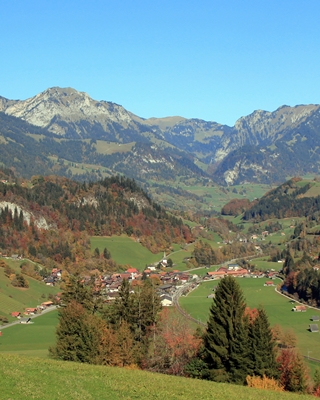
Boltigen Village, with its church visible even at a distance.Compliments of Wikipedia. Photo by Adrian Michael.
|

Description: Reformed in Zurich pulled out of their houses, in 1637
to be executed. Etching, by Jan Lucien, published 1685
Compliments of Rijks Studio
|
|
The 16th century, more so than others, was noted for its religious turmoil, manifested in the Protestant Reformation that would ultimately sweep through the populace in country after country. Simply put, the social and political upheaval it ushered in, caused an undeclared war on some of the differing sects. It was not only Catholic partisans, often in the form of Jesuit Monks, who warred on Protestants, but even Protestants, caught up in religious hysteria, warred on themselves.5 Like the Catholics, the Protestants, also could not accept a group they called Anabaptists. They believed, Anabaptists were putting their children's souls at risk for not being baptized, until older. Hence, Anabaptist beliefs were heretical to the majority, be they Catholic or Protestant. 5 In addition to Anabaptist, there were Jewish Swiss, and other nationalities, whom they all detested. 6 For the various Protestants, persecution began with the Reformation, Anabaptists, as their personal beliefs changed, but the Jews had been the subjects of scapgoating and persecution throughout the centuries.5; 6; 7
The atrocities that were committed were horrible too, including not only death by burning at the stake,6; 7 but child abductions and forced conversions.8; 9; 10 In Switzerland, as early as the 1340s, Jews were being forcibly converted to Catholicism,11 and their persecution continued for hundreds of years. As late as the 1620s, Jews were banished from Swiss towns and villages,12 then forcibly driven out of town after town. Those who refused were killed. 13 The result was throughout the 16th century, as well as others, partisans wrapped in the thralls of religious hysteria, abducted and kidnapped thousands of children from parents who might have been killed or left for dead. Could Michael Studer have been one of the thousands?
|
Again, we can only speculate, but there is evidence from DNA analysis that supports a forced adoption occurrence. The Simmental area, as well as most of Switzerland's German speaking areas, were originally settled by Celtic tribes, predominantly the Helvitti,14 then later Germanic Tribes, commonly called the Alemanni or sometimes Swabians.15 However, the base Haplogroup identified by DNA samples from Colonial Bushong descendants,16 is dissimilar to that of the indigenous population. As such, in those German speaking areas, the vast majority, as would be expected, descend from those early inhabitants, and not those of the Bushong.17; 18; 19
Regardless of his original family's religion, it seems altogether possible that Michael Studer was a victim of the abductions. Following this logic, consider an abducted then adopted Michael Studer. With the Studer name predominently associatied with the Catholic Church,4 as well as, kidnappings more prevalent at the hands of the Jesuits, he would have likely ended up in a Catholic household. Then, his surname and complete identity could very well have been lost or obliterated. Further, it is conceivable that life with adoptive parents and family, could be very different, if not difficult. There is always the possibility that his appearance was different, from the rest of the family, or that he was singled out as adopted, for all his childhood and young life? Was he treated as a second class citizen?
|
|
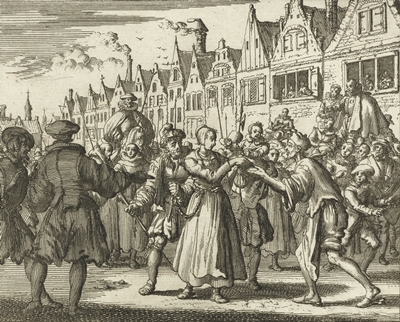
Description: In in 1539 Rotterdam, Anneken Jans is sentenced to death and gives her son, the later Esaias de Lind, to a baker. Etching, by Jan Luyken, published 1685 Compliments of Rijks Studio
|

The Boltigen Church Compliments of Wikipedia.
|
|
So eventually, when Michael Studer grew to manhood and gained autonomy from this adopted family, he would have left them, Especially if he had acquired new religious beliefs they viewed as heretical. However, this time he would have voluntarily converted to Protestant Reformed.1 But for him, the conversion resulted in a total break with the Studers and their name.
Michael Studer became a new person named Boschung, with what was probably for him a new religion, and it was in the Reformed Church where he baptized his first son. It is interesting that there is a virtual absence of the name, "Michael," in the Colonial Bushong family. As a matter of fact, from the Bushong United Tree, there would not be another documented use of it, with any spelling, in the Bushong family for over 300 years, until 1942. 20 This would appear to make Michael the antithesis of a Bushong family name. However, the church books indicate he retained "Michael," though he probably never again used Studer. Interestingly, Michael also went by "Hans" as is seen beginning in 1604 as witness for baptisms.1; View original. For this discussion, and the sake of clarity, his name is retained in order to differentiate him from subsequent Boschungs.
|
After moving to the Boltigen area, Michael and future wife Dichtli Jaggi had a son, Peter Boschung who was baptized in Boltigen Church, on January 12, 1595. 1; View original. Michael and Dichtli eventually married, in February, 1598,1; View original. also in the Boltigen Church. The name Dichtli, is an abbreviated form of Benedikta, which is an old feminine version of a Latin first name, meaning "blessed".21 It commonly refers to Saint Benedict of Nursia, the founder of the Roman Catholic religious Order of Saint Benedict.21 Dichtli was born in Lenk, in Simmental, Bern, Switzerland, May 6, 1576, a daughter of Christian and Elsa Jaggi.22 Some fourteen miles (23km) away from Boltigen, Lenk is an old village that built its first church in 1505.23 A moderately small town, the population of Lenk was 2,265, as of 2010,.23
In January, 1600, Michael and Dichtli, baptized their a son, Hans Boschung I, and though there may be others, the next child we know about was baptized in Zweisimmen on February 9, 1619,1 a daughter named Salomia. Subsequently they had two other children baptized, Madlin October 24, 1620,1 and Christian, January 23, 1623,1 also in Zweisimmen. With the births of a their children, Michael Studer Boschung and Dichtli would become the founders and progenitors of "the Swiss Family Bushong." They began the unique Boschung-Bushong family tree, from which virtually ever American Bushong descends. Sadly, after Christian's 1623 birth and baptism nothing else has yet been found about them and
Michael and Dichtli passed into obscurity. Possibly someday the valley's church books will yield a little more about them, or perhaps the dates, of their passing, but for now all we can say is they died, probably in the Simmen Valley.
|
|

The Iffigsee Lake is very near to Lenk. Compliments of Wikipedia.
|
 *
Hans Boschŭng I *
Hans Boschŭng I
January 18, 1600-June 11, 1669 | |
 *
Anna Anneler *
Anna Anneler
July 20, 1609-October 30, 1690 |
|
*From church book, 1637, in the clerics hand.
Married: March 23, 1629
Their Children
- Jacobia Boschung
- Hans Boschung II
- Jacob Boschung
- Johann Andreas Boschung
|
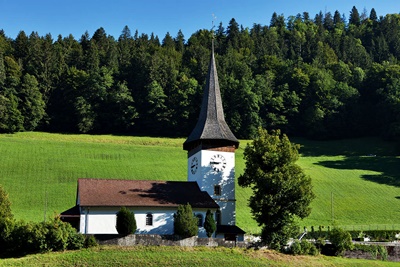
The Boltigen Village Church, where Hans I was baptized.
Compliments of Wikipedia. Photograph by Roland Zumbuehl, 2012.
|
|
The town of Boltigen is quite small and was noted with only 147 household in 1488. The next count in 1764 showed 1300 households, so in 1600 it could not have grown much more than 200 or 300 of households.24 Its population was estimated at 1,313 in 2013.25 However, in Boltigen at the very start of the 17th century Hans Boschung the first, (I) was born. He and his brother Peter are the first known to be born Boschung in what became a new line.
Born to Michael Studer Boschung and Dichtli Jaggi, on Thursday, January 18, 1600, he was named Hanß Boschŭng.1; View original. His first name ending with an "eszett" (sharp S) ß which is pronounced Hanss. As he was baptized in the Boltigen Church,1 Hans became the very first in the American Colonial Bushong family tree to be born a Boschung. Naming him Hans would also begin a tradition that continued unbroken for seven generations, and over 180 years, including in America, its translation, John.26, which is, by far the single most popular name in the family. This also explains the need to differentiate the descending Hans and Johns with the addition of a numerical suffix, in this case, Hans Boschung I. Incidentally, this makes the 1731 American immigrant, Hans John Bushong the fourth IV generation in the Bushong family.27
|
Then, sometime before 1629 Hans I moved four miles, (6.3 km) up the Simmental to Oberwil, where on March 23, 1629 he married Anna Anneler.1; View original. Oberwil was never very large either, and in 2013, its population was estimated at 813. 25 Anna was born July 20 1609, near Oberwil, and was a daughter of Batt Anneler and Jacobe Andrist. Mr Anneler was noted to be a "Landschreibers", which depending on the Swiss canton, was the title for someone who was the head of or a clerk in the cantonal government.28
Hans and Anna's first known child, daughter Jacobia Boschung, (Aegerter), was born about 1631 in Oberwil, as were the rest. Then, son, Hans Boschung II, was born, June 14 1635, Jacob, was born in 1637, and though their could be others, son Johann Andreas Boschung was born about 1641. They were baptized in the St. Mauritius Church in their village.1 The church is quite old and is first mentioned back in 1228 in the church directory of the diocese of Lausanne. Little else of their lives is known. We can assume they lived and worked around Oberwil, and it is possible they farmed. But in the 16th century, their area and virtually the entire Simmen valley had converted from more or less, subsistence farming, to raising cattle and its associated cheese production from milk.29 So it is all together possible the Boschungs, worked in cattle and dairy industries, some of which made the world famous Swiss Cheese. On June 11, 1669,1; View original, (number 13) Hans passed away in Oberwil and Anna died October 3 1690 also in Oberwil.1; View original, (right side, 4th down) .
|
|

Hans moved and the St. Mauritus in Oberwil became his Church. Here is the interior. Compliments of Wikipedia, photograph by By WillYs Fotowerkstatt
|
 *
Hans Boschŭng II *
Hans Boschŭng II
Jun 14 1635-Feb 24 1694 | |
 *
Anna Stocker *
Anna Stocker
May 5, 1641-May 13, 1694
|
|
*From church book, 1663, in the clerics hand.
Married: 14 December 1660
- Hans John Bushong III
- Peter Boschung
- Jacob Boschung
- Anna Boschung (Roschi)
- Christian Boschung
- Madlena Boschung
- Jacoba Boschung
- Salomenia Boschung
- Deboltz?? Boschung
|
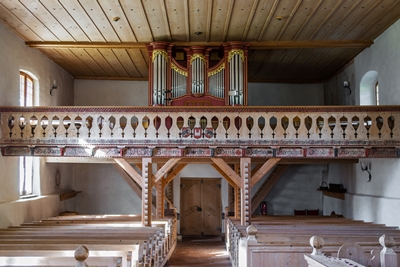
St Mauritus, the Oberwil Church. Through these doors entered three generations of Boschung ancestors. Compliments of Wikipedia, photograph by By WillYs Fotowerkstatt
|
|
Hans Boschung II was born in 1635, in Oberwil, i.S., Bern, Switzerland, and was baptized on Jun. 14, 1635 at the St. Mauritius Church, also in Oberwil. He grew up in the area, and from the church books, he was active in the church. Hans' II, occupation is not known, but as early as 1663 St. Mauritus church clerics began to adding a location or a title as a descriptor following his name. The Oberwil Church scribe wrote, as best as can now be described, "der Irung" in 1663 and beginning in 1670 "der Zölgg," or similar was used. These currently remain a mystery, still a descriptor accompanied his name almost twenty years later in 1681, "der Zolg.".1; View original for 1663 and for 1672. Perhaps it is just their neighborhood and nothing more? Regardless, at 25 years old, on a Tuesday, December 14, 1660, Hans II married Anna Stocker at the St. Mauritus Church, in Oberwil.
|
| Anna Stocker was born May 5, 1641 in Zweisimmen, i.S., Bern, Switzerland, which is down the valley about ten miles, (16km).
Hans and Anna lived in Oberwil and in 1661 their son, Hans John Boschung (Bushong) III was born there, and was baptized June 5, 1661 in St. Mauritus. 1; View original.
They had at least nine children and after Hans III, there was, Peter, in 1663; Jacob Boschung in 1668; Anna Boschung (Roschi), in, 1669; Christian Boschung, born about 1671; Madlena Boschung, in 1672; Jacoba Boschung, 1675, Salomenia Boschung, in 1676; and a son, Deboltz(?) Boschung, in 1681. They were all baptized in Oberwil. However, by the 1680s at least one of their sons, their oldest, Hans III, had left the Simmental and had migrated to Germany.30 Years later, at close to 59 years old, Hans died on February 24, 1694 in Oberwil,1; View original, (number 3 -1694). and Anna died less than three months later, on May 13, 1694 also in Oberwil.1; View original, (number 12 -1694.
|
|
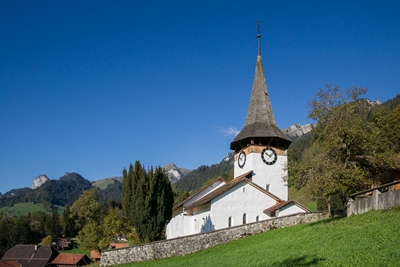
St. Mauritus, the Reformed Church in Oberwil, where the church clerics recorded so many Boschungs. Compliments of Wikipedia, photograph by By WillYs Fotowerkstatt
|
This Article is Copyright ©2018 by Rick Bushong and Commercial Use is Prohibited.
Non-commercial use is permitted if copyright information is included.
References: Our Swiss Family Bushong
Part One: Beyond Bushong
- Parish Records, Boltigen, and Oberwil i.S. Bern, Switzerland
- Google Translator
- Wikipedia: Studer, view here.
- StuderHistory.org view here.
- History Learning Site, view here.
- Peace Mennonite, view here.
- LearnTheology.com, view it here here.
- The Bible is the Other Side view here
- FSU Digital, view here
- Peace Mennonite, view here
- JCPA.org, view here.
- Wikipedia: History of the Jews in Switzerland. view here.
- Guggenheim, view here.
- David Faux: LaTene Celts, view here.
- Wikipedia: Alemanni, view here.
- DNA Proves One Bushong Line, view here.
- R1b-M269 Celtic tribes, and the Helvetii, view here.
- Dispersion ratios, view here.
- More dispersion ratios, view here.
- Michael Dale Bushong 1942-2010. Bushong United Tree.
- Name Doctor: Meaning of Benedikta, view here.
- International Genealogical Index, on FamilySearg.org.
- Wikipedia: Lenk, view here.
- Boltigen: Population
- CityPopulation.de
- John Bushong VII, (1781-1840), husband of Magdalena Bauserman (1778-1832), Bushong United Tree.
- The Bushong United Family Tree
- Wikipedia: Landschreibe, view here.
- Wikipedia: Oberwil, view here.
- Compliments Dietmar Meyer, author, of the Reformed parish Waldfischbach Church Book transcriptions, email communications.
|
Bushong United is Copyright ©2018, 2023 by
Rick Bushong any Commercial Use is Prohibited.
Non-commercial use is allowed with permission or only if entire
copyright is included.
Photographs, unless otherwise noted, are in the commons, and are free use. No bandwidth theft allowed.
To Direct Search the Bushong United Family Tree click here
|
|

















